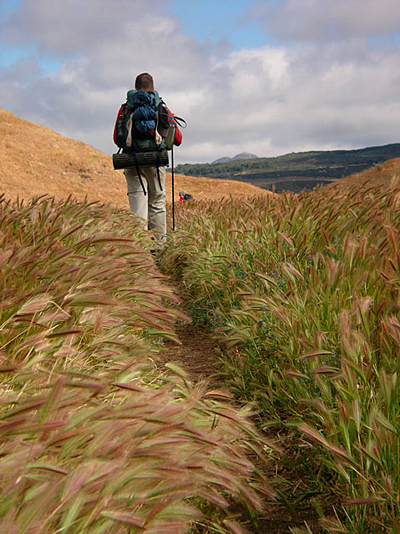Are you considering or planning a thru-hike for next year (or even just for “some day”)? Sorting through a deluge of advice and wondering which to pay attention to? Successful backpackers can tell you what really matters.
In the second of four columns on planning a thru-hike, we discuss: What am I doing out here on the trail? And what am I going to eat and drink?
What am I doing out here?
A few months before beginning a five- or six-month trek on one of America’s long trails, a would-be thru-hiker must make his plans public. He arranges for a leave of absence from work, or tells his boss he will be leaving in April and won’t be back. She looks for someone to house-sit her place for six months, or lets the lease run out and begins putting stuff in storage.
He tells his significant other that he won’t be able to attend her family reunion on the Fourth of July this year … he’ll be out on the trail. She tells Mom and Dad that, no, she won’t be looking for a job right away with her brand new diploma, because she has decided to spend the summer and fall with those weird friends of hers, walking from border to border.
It isn’t always easy to explain why you’re doing this. The decision to tackle a thru-hike — to spend five or six months toting a backpack through forests, mountains, and deserts, going without showers or clean clothes for days or weeks, living without phones, television, and hourly Twittering — strikes many people as, well, crazy.
“First of all, you must believe you are not crazy,” is Triple Crown hiker Jackie McDonnell’s advice to those eager to follow in her footsteps. “Your parents, friends, spouse, others in your life cannot possibly understand why you want to go on this hike. Only you know why,” says the backpacker known as Yogi, who’s completed the Appalachian Trail, Continental Divide Trail, and Pacific Crest Trail. “It’s simply something that you have to do.”
For most people, in fact, it really would be crazy to attempt a thru-hike. It’s a huge undertaking. Hiking from Georgia to Maine or from Mexico to Canada is very difficult, physically and mentally. Also, unlike organized adventures such as guided mountain expeditions or Outward Bound programs, a thru-hike is a completely amateur experience. There are no professionals waiting to swoop in to rescue hikers who get in over their heads — much less a support crew waiting just out of camera range in case someone gets tired of their “reality” show.
Once you’re on the trail, you are on your own. Your fellow backpackers will help you out when they can — as Yogi puts it, “We are your new family.” And trail angels and town residents are amazingly helpful. But you’ll only succeed if you start out accepting that you are responsible for walking from one water source to the next, for getting out of the rain before you risk hypothermia, and for deciding whether the stranger who just walked into the shelter is merely a crank — or someone who should be left miles behind promptly.
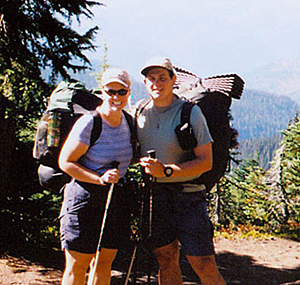
Karen and Andy Somers (trail names: Nocona and Bald Eagle) have backpacked thousands of miles, including in California’s Sierra Nevada, above. (Photo courtesy of Karen Somers)
Who should attempt a thru-hike?
Karen Somers (aka Nocona), who has thru-hiked the AT solo and the PCT with her husband, writes, “A good sign is if you take a solo shakedown hike, end up cold/wet/hot, so scared you can’t sleep all night, limping back to the car with terrible blisters … and still want to go hiking again once you get home. Then, you have the thru-hiker’s bug!”
Who should not attempt a thru-hike?
Anyone who does so purely in the hope of having a life-altering experience that will somehow solve all problems. Don’t choose a thru-hike as a way to grasp an elusive secondary goal, whether it’s discovering your true self, making lifelong friends, losing weight permanently, or deciding whether to get a divorce.
True, any or all of those things might happen. But the only legitimate reason to thru-hike a long trail is because you want to thru-hike a long trail.
The Thru-Hiker’s Obsession: Food
Once you’ve decided a thru-hike is what you really want to do, and you’ve begun getting into shape and purchasing necessary gear (see “Planning a Thru-Hike: Part 1”), it’s time to focus on the topic that becomes a thru-hiker’s daily obsession: food. And more specifically, what to eat and how to get hold of it before you start viewing your fellow backpackers as potential sources of animal protein.
The two main schools of thought on this topic could be described as (1) “plan it and pack it” and (2) “forage and feed on it.”
Plan it and Pack it
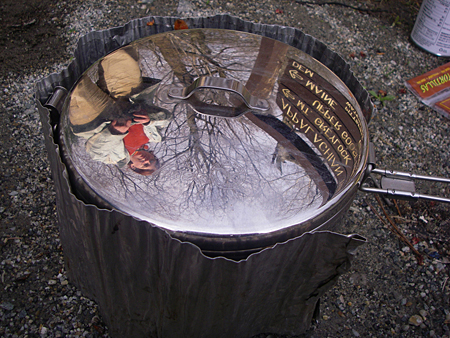
What you cook for dinner will depend on whether you plan your food resupplies in advance or forage along the way. (Photo courtesy of Zyla Nuite and the ATC)
The first approach is to pack resupply boxes for every town stop on the trail and have someone mail them so that they’ll arrive just before you get there.
The advantage is that you’ll get plenty of food (and other necessities, such as first aid supplies, the next section of the map, fresh reading material, and new boots) without worrying about whether there will be any Snickers bars or ibuprofen left in the little campground stores along the trail, and whether the prices will be outrageous.
The disadvantage is that one or more of the boxes might not arrive in time — or that by the time you get the 10th or 11th box in the series, you are thoroughly sick of the very things you packed the most of, and there are still 15 boxes to go.
Join the “plan it and pack it” crowd if:
- You’re an experienced backpacker and you are certain you know what you’re willing to eat, week after week.
- You want to spend your money ahead of time, not be surprised by how much things cost along the way.
- You can predict how much your appetite will increase on the trail, and plan accordingly.
- You know that you can call the long-suffering relatives who are mailing your boxes and they’ll be willing to take out the bags of whole-wheat pasta and organic dried fruit you chose back in March and replace them with the Pringles and dark chocolate M&Ms that you’re craving in June.
Forage and Feed on it
The second approach means purchasing food in trail towns, resorts, and campground stores along the way, which might mean having to hitchhike into a bigger town if the pickings are slim.
Go the “forage and feed on it” route if:
- You’re willing to put up with a fair amount of uncertainty in return for being able to choose a new variety of food at each town stop, and are willing to make detours into town to find that food.
- You want to mail only a few boxes, to those places where you know from your research that not much food will be available, or where you need to have particular items waiting for you. (For example, PCT thru-hikers traditionally mail their ice axes to Kennedy Meadows.)
- Your route and timing are uncertain enough that you don’t want to have to reroute boxes up and down the trail. For example, after a heavy snow year, some thru-hikers “flip-flop” around the trail: hiking those sections that are snow-free and waiting until later in the year to finish the others.
- You’re willing to carry a lot of cash along with a credit card.
Combo Approach
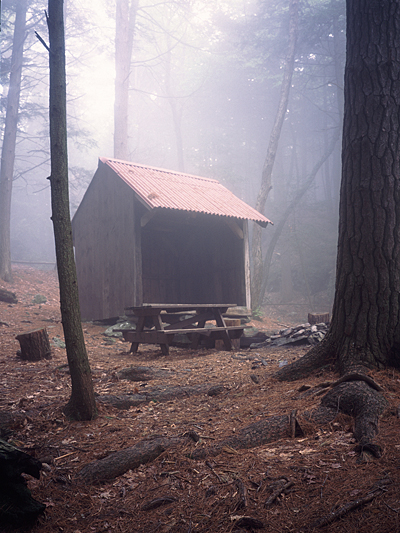
Resupply points on the AT can be as frequent as three to five days apart, but typically are farther apart in in the deep South and far North. (Photo courtesy of John Fletcher and the ATC)
A third, hybrid approach is to send some resupply boxes ahead and also resupply from the trail. You can create your own combination resupply strategy by purchasing food in some places, especially those with large grocery stores, and sending boxes elsewhere, especially to the points where you need to receive stuff that won’t be available in small-town stores (for example, the trail guide for the next section, new boots and socks, or a replacement water filter).
A “bounce box” fits in well with this approach: you collect a box in Town A, which also has a good grocery store, and you buy extra amounts of the food you have come to prefer. Then you mail that box (the bounce box) on ahead to Town C, which doesn’t have good shopping possibilities. In between, you hit Town B, where you plan to stay in a motel and gorge in local restaurants for a day, recovering from your calorie and fresh food deficits of the past couple weeks.
Whether you plan to buy most of your food along the way, or only a few extras to supplement your resupply box, pay careful attention to Yogi’s financial advice: “You damn well better have extra money saved. This costs way more than people lead you to believe.”
I can vouch for that. After four months on the PCT, my family’s appetites for restaurant food and our desire for motel stays increased amazingly, and in order to finish, we had to buy extra cold-weather gear in Portland and Seattle. I’d estimate we spent an extra thousand dollars just to get through Oregon and Washington.
Packing Considerations
How much? Just like what foods to include, how much food to pack is highly individual. According to the ATC, while backpacking can require 3,000 to 4,000 calories a day, a male thru-hiker can burn as many as 5,000 to 7,000 calories a day. However, your appetite may initially be diminished as you set out on the trail, only to return with gusto.
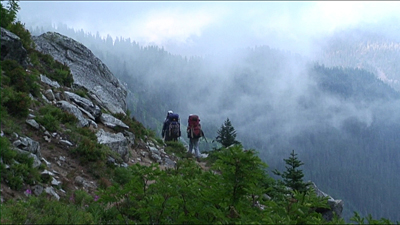
The author and daughter, Mary Chambers, hike through wind, fog, and sunshine, in Washington’s North Cascades. (Photo: Gary Chambers)
The ATC recommends 1 1/2 to 2 pounds of food per day (2 1/2 pounds in cold weather). Estimates can be a good general starting point, but veteran backpackers should consider their specific nutritional needs and preferences, as well as the frequency of resupply options.
Garbage: When packing your resupply box(es), consider the garbage. Once you’ve eaten your food, you’ll have to carry the empty containers to the next campground or town that has a trash can, and on some trails that can mean a week or more. Bears can smell those wrappers, so choose items that don’t leave a smelly residue. And plan to double-bag all garbage. (On our PCT thru-hike, we used Ziploc bags for trash, and then put the trash inside the liners that come with the new Ursacks.)
Also, be aware of food storage regulations in areas you’ll travel through. For example, the PCT passes through black bear and grizzly habitat, with some spots requiring bear canisters. Whatever bear avoidance plan you choose (canister, Ursack, hanging food in trees), practice it beforehand!
The Desert Thru-Hiker’s Obsession: Water
Careful water planning is essential to a successful thru-hike on any trail. Where water is scarce, like southern sections of the PCT and CDT, it’s particularly important. In Southern California, PCT water sources frequently are 20 miles or more apart in areas that reach 100 degrees. On the CDT, sources can be infrequent also, particularly in New Mexico and in Wyoming’s Great Divide Basin. No matter what trail you thru-hike, water planning is an essential part of your preparation.
Find it
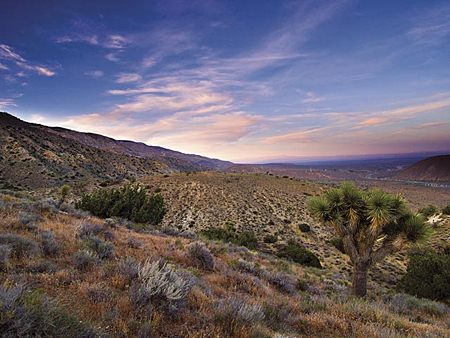
Traveling through the Mojave Desert offers its own water planning challenges on the PCT. (Photo courtesy of Aaron Doss and the PCTA)
Trail guidebooks typically list reliable water sources to help you plan ahead. On the AT, for example, most (but not all) shelters are near a reliable water source. However, some springs and streams may dry up later in the hiking season, so you’ll need to take your timing into account.
A few trail websites provide current water conditions as a service to other hikers, though information may be incomplete or inaccurate. Plan carefully for areas where water availability is a major concern, and be prepared for a non-existent source.
Treat it
Once you’ve located water, consider how you’ll treat it. Even clear, cold, running water can be contaminated with microorganisms. As with other gear choices, water treatment is a very individual decision, and hikers should practice different techniques before deciding on one.
Many thru-hikers opt for lightweight chemical treatments. If chemical treatments appeal to you, use them on practice trips to make sure you can follow the directions, and that the water tastes good enough to drink. The new bottles with built-in filters are becoming popular, but most likely won’t provide enough water for a full day of hiking in 100-degree weather. People planning to use a regular filter or purifier should practice with it, including learning how to clean and maintain their filter out on the trail.
Research the water treatment concerns and suggestions for the various areas you’ll travel through. Then consider your treatment’s effectiveness against the biological contaminants (parasites, bacteria, and viruses) you’re likely to encounter, as well as its convenience and ease of use.
Additional Preparation Tips
Here are a few more nuggets of wisdom from experienced long-trail hikers on how to prepare:
- Do work out a plan that will get you to water, campsites, trail towns etc., on a schedule that will enable you to finish in five to six months. But accept that most of your assumptions will turn out to be wrong and many of your plans will have to be changed on the fly.
- Forget about reading that 1,000-page novel you’ve been saving. Escape literature is what you need when you have a few brief moments to read before falling asleep … or when you’re stuck in your tent or a shelter during a downpour.
- Settle all personal and financial matters before you leave home. Once you’ve left the trailhead, you will have energy only for surviving the trail. If there are birthdays and anniversaries you must remember, make out cards ahead of time and leave them with a trusted friend with instructions on when to mail them.
- Take a phone card along for use at pay phones or in trail angels’ homes. Cell phone coverage is unreliable in the backcountry, and even in many small towns.
- Do plan to keep a journal. Whether you post it online for all the world to see, or just keep it for yourself, it will be priceless.
- Read the label warnings for any medications you’re taking, prescription or over-the-counter, including common anti-inflammatory drugs. Many make you particularly susceptible to sunburn.
Next up, Part 3: Triple Crowners offer advice to first-time thru-hikers on how to stay safe and have fun.
Read the full series:
“Planning a Thru-Hike: Part 1”: tips on choosing a trail, gear, training, and resources.
“Planning a Thru-Hike Part 2”: What am I doing out here? And what am I going to eat and drink?
“Planning a Thru-Hike: Part 3”: advice from Triple Crown thru-hikers.
“Planning a Thru-Hike Part 4”: advice from trail angels.

 by Barbara Egbert
by Barbara Egbert
